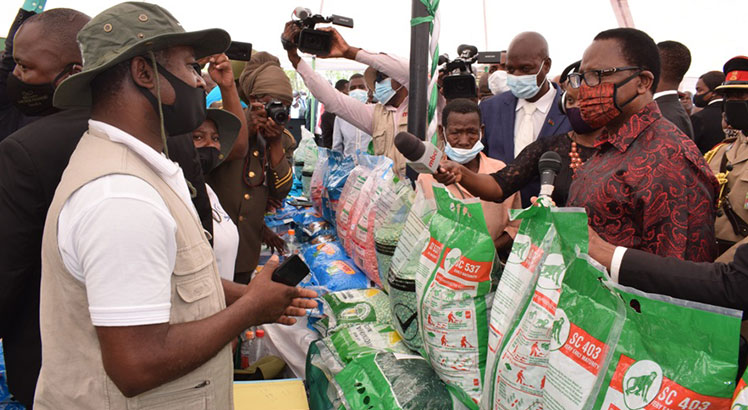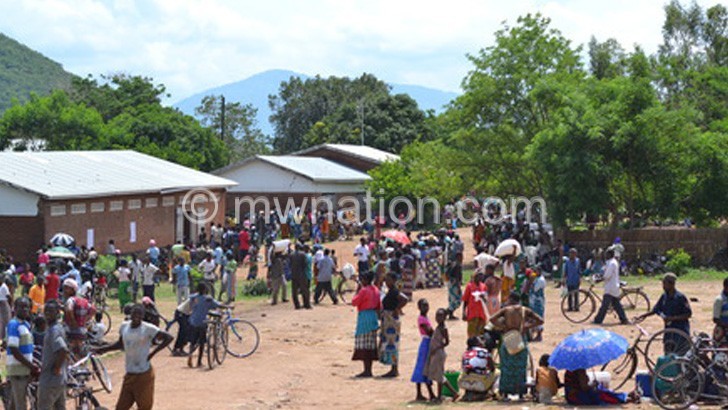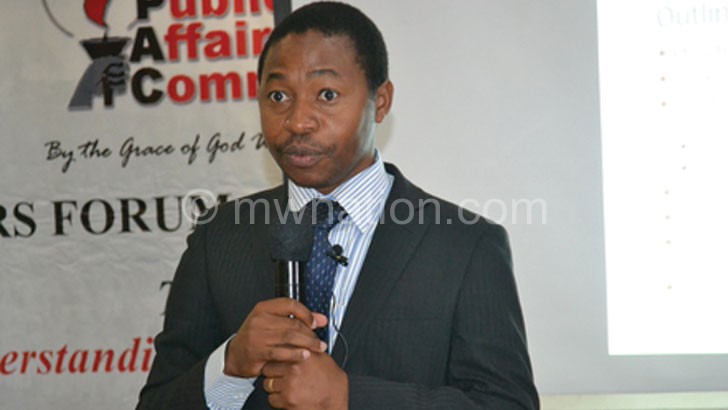Conceptual thinking behind fertiliser subsidies
By Dyton D Maliro, PhD
Gender and Social Protection Specialist
Farm input subsidies in Malawi represent a policy initiative for achieving food security through a truly national approach. Both the ruling party and those in the opposition support the policy and there is no reason to suggest that successive governments will discontinue it.
In the present state of affairs, the use of subsidies in Malawi seems to have a semi-legitimised status among the international financial institutions (IFIs) and aid donors, concerned with chronic hunger and malnutrition. So, time for debates about removal of the policy is over. Critical now is how to manage the policy to achieve the desired policy outcomes. This article is an attempt to contribute to current calls for redesign of the policy. Policy makers and implementers need to understand that the conceptual thinking behind fertiliser subsidies and also the origin of the current subsidies in Malawi are premised on the need to promote the policy as an agriculture science package—high yielding seed varieties, fertiliser, good water environment and agricultural extension effort. Until this is done, not much should be expected from the policy regarding its efficacy.

Conceptual thinking behind fertiliser subsidies in developing countries
It would appear that few people, including policy-makers, understand the conceptual thinking behind fertiliser subsidies. When they talk about fertiliser subsidies, their thinking revolves around the cheap, subsidised fertiliser commodity and not the conceptual reasons fertiliser subsidies are provided to small-scale farmers.
It is important to understand that fertiliser subsidies became a popular policy instrument in low-income developing countries in the 1960s. This period saw the advent of new, higher-yielding varieties of wheat and maize, which began to be adopted rapidly in Latin America and Asia.
A new mainstream thinking emerged, in which small farmers would be encouraged to make a leap forward in production technology, by combining the new varieties with appropriate levels of fertilisers, and (where possible) with sufficient control over water availability (irrigation) in order to ensure that high yields could be attained and sustained. This was the so-called ‘Green Revolution’, also sometimes referred to as ‘the seed-fertiliser-water revolution’.

The adoption of new high-yielding crop varieties offers an even stronger justification for fertiliser subsidies than promoting greater input use with an existing local crop variety. The improvement in crop technology means that higher output is achieved for all different levels of fertiliser input; moreover, the new seed variety may be more responsive to fertiliser than traditional varieties, and over a greater range of fertiliser use. So, the purpose of the subsidy is to overcome farmer reluctance to increase fertiliser use due to risk and credit constraints, and to bring use close to the optimum fertiliser requirements for the new higher yielding crop variety.
In the 1970s, African governments had problems financing sufficient supplies of fertiliser, especially after the oil price crises of 1973 and 1979, resulting in rationing at subsidised prices. From the mid-1980s until the late 1990s, fertiliser subsidies became substantially less prevalent in agricultural policy implementation in Africa. The emerging food crises in Africa in the 1990s are implicated on, particularly, the removal or reduction of fertiliser subsidies. As a result, in the early 2000s, free or subsidised fertiliser packages began to be promoted by international NGOs to help farmers recover from drought or floods, or deal with chronic food insecurity.
The World Bank and others began to talk about ‘smart’ input subsidies, that would be used to kick-start recovery in countries with languishing agricultures, but which (as in the older arguments) would be withdrawn once a recovery was solidly underway. In brief summary of the present state of affairs, the use of subsidies to promote fertiliser use in low income country agriculture now seems to have a semi-legitimised status among the international financial institutions (IFIs) and aid donors, captured by the notion of ‘market smart’ subsidies.
Origins and treatment of current fertiliser subsidies in Malawi
The current input subsidies in Malawi can be traced to 1998 when the government of president Bakili Muluzi implemented the Starter-Pack Scheme (SPS) in 1998-2000. This was introduced in response to a cumulative deterioration in food security that had evolved during the 1990s.
The reasons for this deterioration included adverse side effects of market liberalisation and collapse of public service (1990-94), adverse weather conditions, especially droughts (1991-1995) and floods (1996/97), an influx of Mozambican refugees (1987-1994), the negative effects of HIV and Aids, declining soil fertility and high market price of fertilisers.
A five-year programme of work by a national maize productivity task force, set up by government in 1992 to find solutions to the declining maize productivity and hence food insecurity, presented its findings in 1998. This identified a cost-effective package of maize and fertiliser technology for small farmers with little cash to buy agricultural inputs. The package provided the correct inputs for just 0.1 hectare (ha) of maize, but was considered effective, with good rains, if it was:
lAccessible by all small farmers, . Accessed on time before the onset of the season,
lBased on high productivity and reliable technology (of hybrid seed) with economically efficient doses of fertilisers and
lSupported by a strong mass campaign and a focussed extension effort.
This was to be implemented through the Agricultural Development Division (ADD) structures.
The following sections describe in a brief way the fertiliser subsidy programmes [SPS, TIP, ISP, Fisp and AIP] since 1998 to show how they have incorporated or failed to incorporate the agricultural science package of the national maize productivity task force in their design and implementation.
Starter Pack Scheme (SPS) 1998-2000
This was implemented from 1998/99 season through the ADD structure. The design of SPS incorporated the recommendations of the National Maize Productivity Task Force. It provided every farm family an input package comprising hybrid maize seed (2 kgs), legume seed (2 kgs), basal fertiliser (10 kgs 23:21:0+4S) and top dressing fertilizers (5 kgs Urea) adequate for 0.1 hectare of maize.
While SPS seemed to demonstrate good potential for raising maize yields and output in Malawi, it was halted after two years due to disagreements between donors, regarding its advisability. Specifically, the World Bank opposed a universal scheme, and DfID, which had provided technical support and funded SPS, eventually gave way to the Bank’s position. SPS was replaced by a scaled-back version that came to be known as the Targeted Input Programme (TIP), implemented from the 2000/01 season.
Targeted Input Programme (TIP) 2000-2004
TIP, which was implemented through the ADD structure, incorporated the following changes to the starter-pack: (a) the number of beneficiaries was reduced to 0.4 million farmers (later increasing to 1.5 million farmers, due to recurring hunger events); (b) the size of the input package was reduced to 0.08 hectares maize area (2 kg maize seed, 1 kg legume seed and 12 kgs fertiliser); and (c) the seed was changed from hybrid to OPV maize. Unlike the starter-pack that enjoyed good rains, TIP coincided with a series of adverse weather events, mainly floods in 2000/01 and droughts in 2001/02 and 2003/04, but the fall in maize production and ensuing hunger tended to be attributed in government circles to the scaling down of the starter pack.
Input Subsidy Programme (ISP) 2005-2010
The 2004/05 crop season produced the lowest maize output in a decade. It coincided with the new government of Bingu wa Mutharika, elected in May 2004, who had campaigned on scaling up input subsidies to end hunger in Malawi. In 2005, the government moved to comply with its campaign promises and introduced the ISP in defiance of majority donor views. The ISP varied in coverage in successive seasons. It set out to reach 1.7 million farmers (roughly 60 per cent of all small farmers) in 2006/07, while in the other years it sought near universal coverage. It provided 5 Kgs fertiliser, 2 Kg of OPV maize and 1 Kgs legume to some 1.2 million to two million farm families. The annual output ranged from 1.5 to 1.8 million metric tonnes of maize.
The ISP was a complex programme involving many activities and stakeholders. The Ministry of Agriculture implemented ISP through district councils but lacked consistency. The main emphasis of ISP was on maize but coupons were also issued to tobacco, tea and coffee farmers.
At community level, some activities were implemented through extension workers, some through village heads and some through village input subsidy committees. There were increasing cases and speculations about tensions between different government departments, corruption, nepotism and mismanagement of public resources, most probably emanating from confusion created by the failure to establish institutional boundaries among the implementers.
The more serious proposition had been advanced that the ISP was systematically permeated by institutionalised coupon syndicates comprising (a) politicians, including ministers, using political influence to obtain large blocks of coupons for sale; (b) government officials obtaining substantial quantities of coupons for sale; (c) traditional leaders on their own or as conduits for broader syndicates selling instead of distributing coupons, (d) workers at coupon printers stealing large quantities of coupons, (e) criminal groups printing and selling fake coupons or using fake coupons to buy fertiliser for resale. There were years in which the same fertiliser supplier was also contracted to distribute the fertiliser and to monitor the fertiliser distribution throughout the country. These irregularities could help to explain weak accounting of subsidy resources, and reluctance of the government to produce transparent accounts of funds allocated to the programme.
In summary, the official output levels during ISP implementation varied considerably; however, there are serious concerns about the accuracy of the output figures. ISP output figures diverged sharply between official production as estimated through Agricultural Production Estimate Survey (Apes) and consumption requirements as estimated by Malawi Vulnerability Assessment Committee (Mvac) studies. The size of the gap between declared harvests (Apes) and missing food entitlements (Mvac) was almost certainly much too large; indicative of substantial overestimates of production.
Farm Input Subsidy Programme (Fisp) 2010-2020
The government in March 2010 formulated a six-year Medium Term Plan (2010/11-2015/16) for the input subsidy programme, which later came to be known as the Farm Inputs Subsidy Programme (Fisp). Before then, issues around input subsidies in Malawi were managed on ad hoc basis mostly as Cabinet directives and donor concessions.
Ministry’s Management provided overall policy guidance. District councils, especially District Commissioners (DCs) and District Agricultural Development Officers (Dados) implemented the programme. Subject Matter Specialists at Agricultural Development Division (ADD) backstopped the implementation through monitoring and supervision.
Fisp targeted smallholder farmers who owned land and were legitimate residents of their villages. It varied in coverage in successive seasons, ranging from 900 thousand households to 1.6 million households. It was administered through vouchers or coupons that enabled eligible households to purchase fertiliser, hybrid seed, and pesticides at reduced prices. It allowed each beneficiary household to redeem 50 Kgs NPK ((23:21:0:4S or 23:10:5+6S+1.0Zn) and 50 kg urea plus 5kgs hybrid maize or 8 kgs OPV and 3kg of soybean or 2k go for the legumes (beans, cowpeas, pigeon peas, or groundnuts).
The Fisp design allowed a beneficiary household to receive two coupons to redeem two 50-kgs bags but in practice, some households received one voucher, redeeming one bag of fertiliser. Even with the reduced number of bags, beneficiary households were encouraged or coerced by local leaders to share the 50 kg fertilizer with 1-2 non-beneficiary household. Despite the sharing, when it comes to the level of benefit, wealthier households were slightly better able to capture more of the fertiliser subsidy. Concerns have also emerged that agricultural extension system did not reach out sufficiently to the farmers, potentially undermining the benefits of the FISP.
Official output levels during the 10 seasons of Fisp implementation varied considerably, ranging from 3.895 million tons in 2010/11 to the lowest 2.158 million tons in 2018/19 but generally impressive. Retail prices of food maize remained generally stable especially in the FISP years. Overall, the FISP has been heralded as successful despite implementation challenges related to corruption, conflict, poor distribution and access, reselling inputs by poorer farmers, elite capture by large-scale farmers, diversion from intended crops and cross-border leakages.
Affordable Input Programme (AIP) from 2020
During the re-run of the Presidential Elections that was held in June 2020, the Tonse Alliance led by Dr Chakwera had campaigned on the promise of implementing a universal subsidy programme, pegging fertilizer price at K4 495 against a market price of over K20 000 per bag of 50 kgs.
The Tonse government made good on its June 2020 election promise of making fertiliser far much cheaper by introducing the Affordable Input Programme (AIP) with farmers redeeming a 50 kg bag of fertiliser at K4 495. The main goal of the AIP was to attain food security at household and national levels and reduce poverty through increased access to improved farm inputs – fertilizers and certified seeds.
As a universal subsidy programme, AIP targeted all the 4.3 million farming households in the updated MoA registry (AIP reached 3.8 farming households in 2020/21season). The MoA database was linked to National Registration Bureau (NRB) database. A beneficiary household was provided with vouchers to redeem one 50kg bag of Urea, one 50kg bag of 23:10:5+6S+1.0Zn and either 5kg of hybrid seed or 7kg of OPV maize seed or 7kg of rice seed or 7kg of sorghum seed.
Ministry of Agriculture implements the programme in close collaboration with a national task force that comprised Ministry of Local Government, Ministry of Information, Ministry of Civic Education and National Unity, E-government, the Malawi Police Service and Anti-Corruption Bureau. District Commissioners (DCs) and District Agricultural Development Officers (Dados) implemented the programme through beneficiary selection and voucher distribution. ACB monitors and supervises the implementation.
Contracted companies managed the supply, distribution and recoupment of the fertiliser and seed vouchers in the Extension Planning areas (EPAs) where they applied for and were authorised to trade in the subsidized inputs. Innovations in the 2020/21 AIP included linking the MoA database to NRB and the use of electronic devices and national identity cards in redeeming the vouchers. Apart from ACB use of Information Education and Communication (IEC) materials and Radio programmes to sensitise the public on corruption, there is no evidence to suggest that the programme was adequately or deliberately supported by agricultural technical messages.
The ambition and scale of the AIP has been admirable, and it is widely agreed that the scheduling and timeliness of the input distribution has in general been fairly well done. Production estimates released in March 2021 suggested a maize output of 4.4 million metric tonnes, attributable to an above‑average planted area, high yields and favorable weather conditions. The 2020/21 AIP is yet to be subjected to proper independent evaluations but there are indications of some challenges that include intermittent network, late delivery of inputs in some selling points, registration of multiple beneficiaries under one household, and side-selling of AIP fertiliser. The real output effects of the programme are not yet ascertained.
In the 2021/22 season, AIP planned to reach out to one million less beneficiaries (from 3.8 beneficiaries in 2020/21 to 2.7 million farmers). A 50 kg bag of fertiliser would be redeemed at K27 000 which represents a sharp rise from the campaign promise of K4 495. With these developments, the tone of debate among the electorate is that of government going against its campaign promises.
However, Government in 2021/22 AIP has awarded contracts to 63 suppliers to supply 60 thousand goats amounting to K1.2 billion under AIP. A total of 33 000 farmers would benefit from this newly created livestock component in the 2021/22 farming year. Each family would get two goats. The beneficiaries would be farmers who do not use the fertiliser but sell the AIP fertiliser. Instead of inputs, such farmers would be encouraged to buy the goats.
Conclusion
This article reprises the original conceptual thinking behind fertiliser subsidies in developing countries, as well as summarizes the treatment of the current policy in Malawi. Conceptually, fertilizer subsidies are provided to play two important roles – to promote optimal use fertiliser on an existing seed technology such as local maize seed, and to promote adoption of new high yielding seed varieties such as hybrid maize. Availability of support systems such as good watered soils (irrigation), agricultural extension services and functioning input and output markets is part of this conceptual thinking to provide a continuum of service for the fertiliser subsidy to perform the expected role.
This agricultural science was embedded in the Green Revolution (seed-fertiliser-water revolution) in Asia in the 1960s. The output effects were amazing, transforming the hungry Asia sub-continent into a food surplus, exporting region. Malawi has tried to adopt this conceptual thinking during the SPS and the output effects were unquestionable. So, not much should be expected regarding the efficacy of the fertiliser subsidy policy if elements of agricultural science (high yielding seed varieties, good water, fertiliser and agricultural extension) are missing in the design and implementation of the policy.n
About the Author
Dyton Maliro (dytonmaliro@gmail.com) holds a PhD in International Development (Social Protection) from the University of East Anglia (UEA) in the UK. He currently works as Social Safeguards Specialist for the Agricultural Commercialisation Project in the Ministry of Agriculture but here, he is writing in his personal capacity.






One Comment